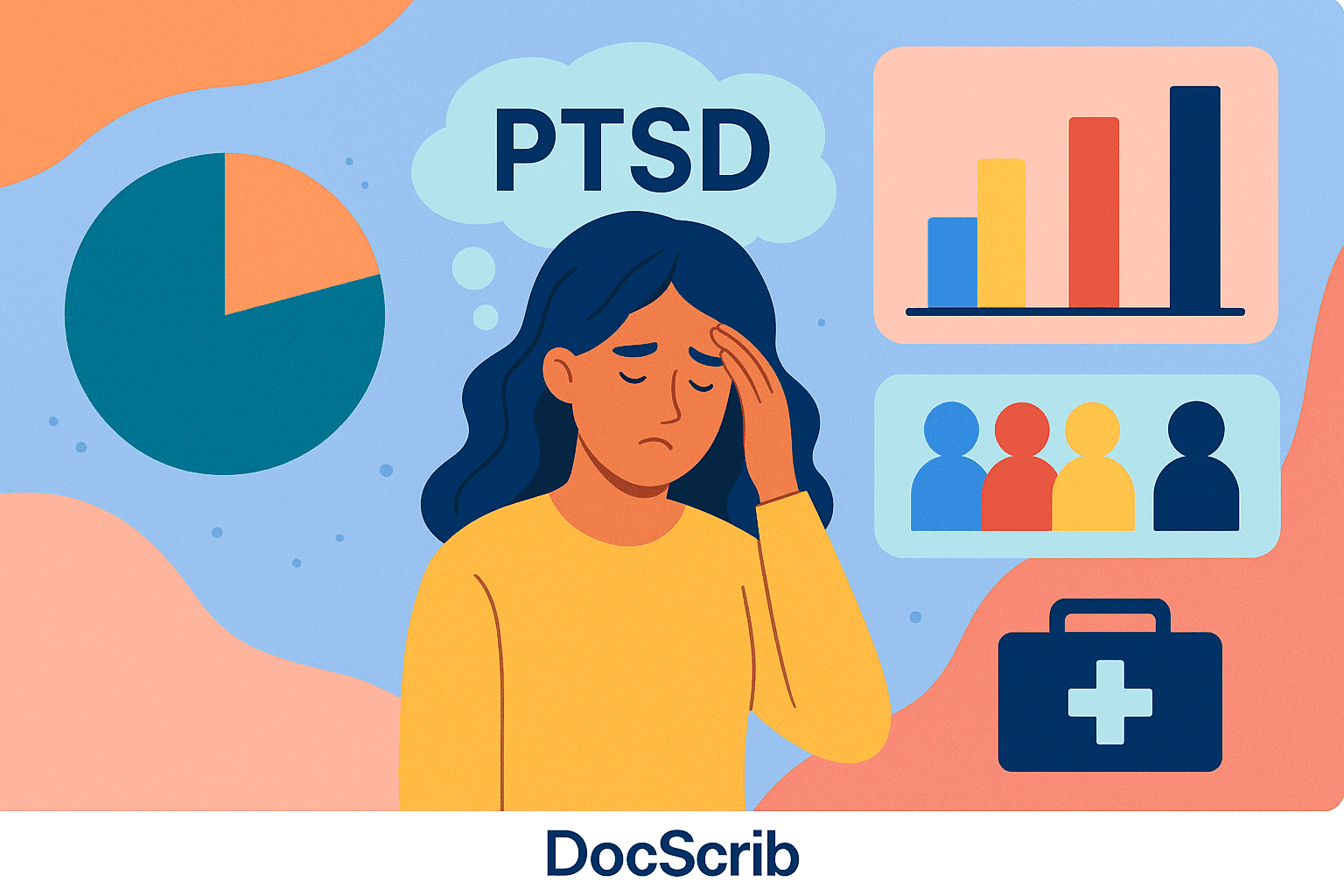Updated on: July 24, 2025
What Is PTSD and Why ICD‑10 Coding Matters
Post‑traumatic stress disorder (PTSD) is a trauma- and stressor-related psychiatric disorder that develops following exposure to actual or threatened death, serious injury, or sexual violence. Accurate diagnosis and billing require using ICD‑10 codes, especially in settings using international standards or submitting insurance claims.
ICD‑10 Codes: From F43 to Subcategories
F43 Reaction to severe stress, and adjustment disorders breaks down into:
- F43.1 – PTSD general (not billable alone)
- F43.10 – PTSD, unspecified
- F43.11 – PTSD, acute (symptoms 1–3 months)
- F43.12 – PTSD, chronic (symptoms >3 months)
Symptom Duration & ICD‑10 Subcodes
| Code | Duration | Use Case |
|---|---|---|
| F43.10 | Unspecified | Unable to determine duration |
| F43.11 | 1–3 months | Acute onset |
| F43.12 | >3 months | Chronic or long-standing cases |
Providers may also specify delayed expression: onset six months post-trauma.
Diagnostic Criteria per ICD‑10
To code PTSD correctly, patients must meet criteria:
- Exposure to an exceptionally lethal/stressful event
- Persistent reliving or distressing thoughts
- Avoidance of reminders
- At least two arousal symptoms (e.g., sleep disturbance, irritability, concentration difficulty, exaggerated startle)
PTSD Prevalence: Global, Gender, and Occupational Insights
Global Burden
- About 70% of people experience trauma; but only around 5–6% develop PTSD
- Lifetime global prevalence is approximately 3.9%
Gender Differences
- Lifetime prevalence: women ~10–12%; men ~5–6%
- Women are 2–3× more likely to develop PTSD and 4× more likely to have chronic PTSD
- In the U.S., past-year PTSD prevalence: women ~5.2%; men ~1.8%
Occupational Risk
- First responders: firefighters (~7.3%), police (~4.7%), paramedics (~14.6%), rescue teams (~13.5%)
- Health-care workers post-pandemic: ~26.9%; infected individuals: ~23.8%; general public: ~19.3%
Elder Veterans
- Veterans Affairs data: ~13% of VA users versus 4% of non-VA veterans have current PTSD
- Lifetime estimates: VA users ~23%, non-users ~7%
Risk Factors and Traumatic Events
- Type of trauma: Sexual violence has the highest risk (~11–19%), followed by combat (~22%)
- Childhood adversity: Approximately 16% of children post-trauma develop PTSD
- Genetics: About 30% variance is attributable to genetic predisposition; strong overlap with depression and anxiety (up to 60%)
Charting PTSD’s Global Footprint
You can use the following visuals on DocScrib:
- Pie chart – Trauma exposure (70%) vs PTSD diagnosis (5.6%) globally
- Bar chart – Gender differences in lifetime PTSD prevalence
- Stacked bar – PTSD rates by occupation (general public, healthcare workers, first responders, veterans)
Diagnosing and Coding Accurately
To ensure accurate ICD‑10 coding:
- Conduct structured clinical interviews
- Rule out differential diagnoses such as major depression, adjustment disorder, or substance use disorder
- Choose the correct ICD‑10 code based on symptom duration (e.g., F43.12 for symptoms lasting more than 3 months)
- Specify “with delayed expression” if the onset occurs more than six months after trauma
Treatment: Evidence-Based Approaches
First-line Psychotherapy
- Trauma-focused Cognitive Behavioral Therapy (CBT): Includes cognitive processing therapy, prolonged exposure therapy, and narrative exposure
- Eye Movement Desensitization and Reprocessing (EMDR): Widely validated alternative to CBT
Pharmacotherapy
- SSRIs such as sertraline and paroxetine are FDA-approved for PTSD treatment
- While effective, 40–60% of patients show partial or no response
- SNRIs and atypical antipsychotics may be used off-label in treatment-resistant cases
Adjunctive & Emerging Interventions
- Mindfulness and Yoga: Improve emotional regulation and reduce symptoms
- Mobile apps & VR therapies: Used increasingly in young populations
- Ketamine therapy and Stellate Ganglion Block (SGB): Being investigated for rapid symptom relief
Coding & Billing Best Practices
- Never bill using F43.1 alone—it is not billable. Always use a specific subcode (F43.10, F43.11, or F43.12)
- Accurately document:
- Duration of symptoms
- Severity and functional impairment
- Triggering traumatic event
- Onset pattern (immediate or delayed)
- Ensure EHR templates and billing software are updated to reflect ICD‑10 compliance
Toolkit for Clinicians & Administrators
You can equip your team with:
- ICD‑10 Quick-Reference Table – With definitions and use cases for F43.10–F43.12
- PTSD Symptom Checklist – Aligned with ICD‑10 diagnostic criteria
- Diagnostic Flowchart – Unspecified → Acute → Chronic → Delayed
- Coding FAQ Sheet – Definitions, case examples, common errors, documentation dos/don’ts
Public Health & Policy Considerations
- Mental health care gaps remain high—76–85% of individuals in low- and middle-income countries receive no treatment
- In high-income countries, that gap is still 35–50%
- PTSD Awareness Month (June) and National PTSD Awareness Day (June 27) are key efforts to drive education, de-stigmatization, and early intervention
- Military personnel, disaster victims, healthcare workers, and refugees should be prioritized in national trauma-informed care policies
Conclusion
PTSD is both prevalent and underdiagnosed. Understanding the nuances of ICD‑10 coding—particularly the distinctions between F43.10 (unspecified), F43.11 (acute), and F43.12 (chronic)—helps clinicians document accurately, bill correctly, and deliver more targeted care.
In a world where trauma is increasingly acknowledged but still poorly managed, proper PTSD diagnosis and treatment remain essential for long-term recovery. With the right tools, documentation standards, and evidence-based practices, clinicians can make meaningful strides in healing patients impacted by trauma.
Experience seamless, AI-powered documentation with DocScrib.
Streamline your clinical workflow and reduce admin burden.
Click here to book your free demo.
